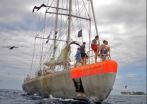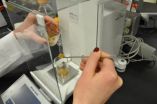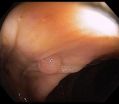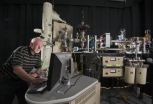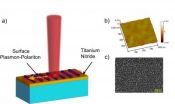(Press-News.org) HEIDELBERG -- The two-and-a-half-year TARA OCEANS expedition finishes on 31 March when the ship and crew reach Lorient, France. The arrival completes a journey of 60 000 miles across all the world's major oceans to sample and investigate microorganisms in the largest ecosystem on the planet, reports Eric Karsenti in an editorial published today in Molecular Systems Biology.
"Life and evolution started in the oceans, yet we know very little about the distribution of marine biodiversity," said Karsenti, senior scientist at the European Molecular Biology Laboratory in Heidelberg, Germany, and Co-Director of the TARA OCEANS project. "If it were not for these microorganisms we would not exist. First, we are their evolutionary descendants and second they generate the atmosphere of the Earth."
The scientists taking part in the TARA OCEANS expedition want to understand how the populations of microscopic organisms that make up 98% of life in the oceans interact with the environment and how these complex systems have evolved over time. "It is an interplay between the different species and each species affects the environment," explained Karsenti in a live interview with Molecular Systems Biology. "Oceans are very heterogeneous both geographically and at different depths — each water mass has a different ecosystem."
Recent advances in DNA sequencing and automated microscopy have accelerated the large-scale research needed for this type of project. In addition, the availability of powerful data processing methods makes it possible for scientists to build a global systems biology map of the interactions between the environment and the microorganisms that inhabit the oceans of the world.
The goal of systems biology is to map, understand and model the whole network of interactions that make up life. "Systems biology can be applied at any organizational level of living organisms, from molecular interactions to ecosystems and evolution," remarked Karsenti.
Samples taken from different depths of water provide access to detailed information on the genetic makeup of the marine microorganisms as well as their shape and physical environment. When combined with real-time satellite imaging of the oceans, the vast amounts of data can be used as a starting point to build predictive computational models of the diversity of microorganisms in the ocean as well as their evolution. "We hope to use the data to feed computational models that will describe the evolution of marine ecosystems," said Karsenti.
The project brings back samples from 155 stations taken from all the main oceans on the planet. "After the completion of the ocean voyage and the collection phase of the operation, the land-based investigation is truly picking up speed," concluded Karsenti.
INFORMATION:
Towards an "Oceans Systems Biology" Karsenti E.
Read the editorial: http://www.nature.com/msb/journal/v8/n1/full/msb20128.html
Listen to the Podcast: http://www.nature.com/msb/podcasts_videos/index.html
Further information on Molecular Systems Biology is available at http://www.nature.com/msb
Learn more about the TARA OCEANS expedition: http://oceans.taraexpeditions.org
Media Contacts
Barry Whyte, Head | Public Relations and Communications
Yvonne Kaul, Communications Offer
Tel: 49-6221-8891-108/111
communications@embo.org
TARA OCEANS completes 60,000-mile journey to map marine biodiversity
2012-03-27
ELSE PRESS RELEASES FROM THIS DATE:
Parsing the Pill's impact on women's wage
2012-03-27
ANN ARBOR, Mich. -- Although women continue to lag behind men in pay, the gender wage gap has narrowed considerably since the 1960s. Now a new University of Michigan study is the first to quantify the impact of the pill on women's labor market advances.
The study shows that roughly one-third of women's wage gains through the 1990s are due to the availability of oral contraceptives.
Published online this week by the National Bureau of Economic Research as a working paper, the study was conducted by U-M economist Martha Bailey and colleagues Brad Hershbein at U-M and ...
Mustard -- not just for hotdogs anymore, research shows
2012-03-27
University of Alberta researcher Christina Engels has discovered how to extract a compound from mustard seeds that can protect against food spoilage.
Engels recovered a particular compound—sinapic acid—from mustard seed meal, which shows antibacterial effects against such strains as Staphylococcus aureus, E. coli and Listeria monocytogenes, all of which can cause grave illness and death in humans. Canada is the world's largest exporter of mustard seed.
The results published recently in the European Food Research & Technology journal>.
Engels' isolation of sinapic ...
Smyrna GA Hotel Offers Close Lodging to the 2012 Spring Jonquil Festival
2012-03-27
Hampton Inn & Suites Atlanta Galleria Hotel, a premier Smyrna Georgia Hotel, offers convenient lodging for guests and vendors attending the Spring Jonquil Festival. The event will take place April 28-29, 2012 on the beautiful Village Green in downtown Smyrna, GA. The event will showcase arts and crafts by more than 150 artists/crafters from across the country. It will also feature:
- Featured Artist's Market
- Live entertainment including country music performer J. Scott Thompson
- Children's section with Peter's festival puppet show and inflatable actives
- ...
LaMichael James Brings Tools for Success to His Alma-Mater High School
2012-03-27
Yesterday, pro football prospect LaMichael James surprised students at Liberty-Eylau High School, his alma mater in Texarkana, Texas, with tools for achieving their best on the field and in life. James and representatives from SKLZ, the athletic training company for which he is a brand ambassador, shared how hard work and dedication can lead to academic and athletic successes. In addition to the words of encouragement, James donated $5,000 of SKLZ training equipment to the Liberty-Eylau High School to help its student athletes elevate their athleticism.
"When you're ...
Poor colonoscopy prep hides pre-cancerous polyps
2012-03-27
What happens on the day before a colonoscopy may be just as important as the colon-screening test itself.
Gastroenterologists at Washington University School of Medicine in St. Louis have found that when patients don't adequately prep for the test by cleansing their colons, doctors often can't see potentially dangerous pre-cancerous lesions.
Reporting in the journal Gastrointestinal Endoscopy, the researchers say that doctors often missed at least one pre-cancerous growth in about one-third of patients who did not properly prepare for their colonoscopy. Those polyps ...
Research into children with autism published in JoVE
2012-03-27
Though the prevalence of autism spectrum disorder (ASD) has been steadily climbing— from 6 in 1,000 children in 2002, to nearly 10 in 1,000 children in 2006, according to the Centers for Disease Control and Prevention— little is known about the disorder. But, research with young kids can lead to important insights in how children with developmental abnormalities view the world. This month in the Journal of Visualized Experiments, researchers demonstrate how to use eye-tracking in very young children with autism.
"Generally, individuals new to this method often struggle, ...
Harvard’s Wyss Institute creates living human gut-on-a-chip
2012-03-27
Researchers at the Wyss Institute for Biologically Inspired Engineering at Harvard University have created a gut-on-a-chip microdevice lined by living human cells that mimics the structure, physiology, and mechanics of the human intestine—even supporting the growth of living microbes within its luminal space. As a more accurate alternative to conventional cell culture and animal models, the microdevice could help researchers gain new insights into intestinal disorders, such as Crohn's disease and ulcerative colitis, and also evaluate the safety and efficacy of potential ...
Sandia National Laboratories' Ion Beam Laboratory looks at advanced materials for reactors
2012-03-27
ALBUQUERQUE, N.M — Sandia National Laboratories is using its Ion Beam Laboratory (IBL) to study how to rapidly evaluate the tougher advanced materials needed to build the next generation of nuclear reactors and extend the lives of current reactors.
Reactor operators need advanced cladding materials, which are the alloys that create the outer layer of nuclear fuel rods to keep them separate from the cooling fluid. Better alloys will be less likely to deteriorate from exposure to everything from coolant fluids to radiation damage.
Operating a reactor causes progressive ...
Boston University researchers develop microfluidic chip to stem flu outbreaks
2012-03-27
BOSTON -- The H1N1 flu pandemic in 2009 underscored weaknesses in methods widely used to diagnose the flu, from frequent false negatives to long wait times for results. Now Boston University researchers have developed a prototype of a rapid, low-cost, accurate, point-of-care device that promises to provide clinicians with an effective tool to quickly diagnose both seasonal and pandemic strains of influenza, and thus limit the spread of infection.
Boston University Biomedical Engineering Associate Professor Catherine Klapperich led the team of engineering and medical researchers ...
Researchers discover a new path for light through metal
2012-03-27
WASHINGTON -- Helping bridge the gap between photonics and electronics, researchers from Purdue University have coaxed a thin film of titanium nitride into transporting plasmons, tiny electron excitations coupled to light that can direct and manipulate optical signals on the nanoscale. Titanium nitride's addition to the short list of surface-plasmon-supporting materials, formerly comprised only of metals, could point the way to a new class of optoelectronic devices with unprecedented speed and efficiency.
"We have found that titanium nitride is a promising candidate ...
